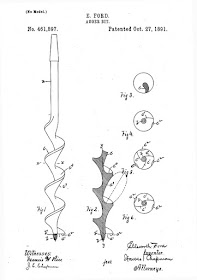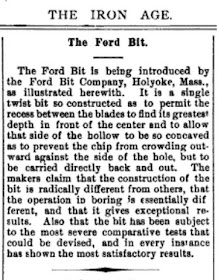Wednesday, September 30, 2015
1969 Suzuki T250 and T350
My brothers and I put many hard miles on examples of both these models. The high bars were discarded immediately, in favour of cafe or race-inspired drop bars.
Model T Air Transport Truck
Ford got into the airplane business in 1925, buying the Stout aircraft company and starting a dividion named the Air Transport Service. This truck with a polished aluminum (or Monel, depending on the source) body was built as a promotional item and used for ground support.
 |
| Floyd Clymer, Henry's Wonderful Model T 1908-1927 Bonanza Books 1955 |
Pictured with the Ford/Stout Maiden Dearborn aircraft in 1925 at the Michigan State Fair. The airplane was originally developed by Stout Engineering as the 2-AT Pullman in 1924 and was the basis of the Ford Trimotor. Eleven were built, all were scrapped in 1928. .
Tilting chair test, 1958
Two-Fister screwdriver
Above, my Two-Fister screwdriver, made of "unbreakable ebonoid plastic," whatever that was.
Long-handled screwdrivers go back to the wooden-handle days:

"Two-fister" screwdrivers were made by Rosco, which was acquired by Vermont American in 1974. The parent company then had the business sense to trademark the Two-Fister name in 1984. No one seems to make them anymore.
 |
| From ebay |
 |
| 1989 |
Tuesday, September 29, 2015
Trestle on the Esquimault and Nanaimo Railway
Telegraph letterheads, 1939
Boring History 4: Ford Bit Company, Holyoke, Massachusetts
Over the weekend, I picked up an old cigar box with a handful of rusty twist and auger bits for $2. They cleaned up nicely on the wire wheel, and a number of them were from manufacturers I hadn't encountered before. This is one such.
In 1891, Ellsworth Ford, then of New Haven, Connecticut, was granted a U.S. patent for an improved design of auger bit:
Below, from The Iron Age, December 15, 1892:
According to Old Tool Heaven:
"In 1916, the Millers Falls Company took advantage of an opportunity to “purchase outright the stock, machinery, good will and any other assets” of the Ford Auger Bit Company of Holyoke, Massachusetts. Although Millers Falls had been selling augers for decades, the purchase marked its first foray into the actual manufacture of the product. Ford Auger Bit had established a solid reputation on the basis of its manufacture of Ellsworth Ford’s 1891 design for an improved, single twist auger bit. The firm’s single twist, single lip models cut aggressively, provided good chip clearance and were favored by many workers for use in basic carpentry. Although single lip bits do not produce the clean, well-defined hole of the double lip varieties, they were marketed as being faster cutting, as operating with less friction and as being especially useful in end grain and green, wet or knotty wood. Since Ford Auger Bit was also making single twist, double lip and solid center bits at the time of its purchase, the Millers Falls Company had no trouble including a full array of augers in its 1917 catalog. Of special interest is the “Hummer bit,” a single lip bit designed for fast work in softwoods. The Hummer was capable of boring through inch-thick pine stock in six rotations—twice as fast as a typical single lip Ford bit and three times as fast as a cabinetmaker’s double lip model."In addition to offering four variations on standard-sized carpenter’s bits, the company sold machine bits, car bits and ship augers. Custom orders were also taken. Certainly the most interesting of these was the bit designed to drill through the timbers used in constructing the locks of the Panama Canal. At the time, the Panamanian auger—a monster boring device—was considered to be the longest auger bit in the world. The company continued to manufacture auger bits at its Millers Falls plant until 1946, when the line was sold."
Monday, September 28, 2015
Electric Triumph
 |
| Canadian Motorcycling, April 1971 |
Everyone else, "HAHA HA HA...
This electric conversion of a Triumph Trailblazer was built for the Royal Signals motorcycle display team (six members shown) for use in their indoor trials circuit. The girl at the center of attention is apparently actress Caron Gardner.
I wish the picture was better, it's hard to make out details of the conversion, other than the bungee-corded automotive battery mounted on a piece of plywood.
Tecomaster Model X reel-type lawn mower
Seen last weekend at a garage sale. The name "Teco" was derived from the T.Eaton Company, at one time a large department store chain that rivalled Sears in Canada. Interesting that Eatons sourced the lawnmower from England rather than from local manufacturers like Smarts in Brockville, Ontario or Maxwells in St, Marys, Ontario which also made these things.
Sunday, September 27, 2015
Bateman's Velocette
The bikes in the ad were among the last of the production at Velocette. The very last Thruxton made, bought at Batemans, is still in Ontario.
Canadian National #9000
Nick and Helma Mika, Railways of Canada, McGraw-Hill Ryerson 1972
Canadian National's first diesel, 1929
This is the Enemy
 |
| Paul W. Bennett, et al. Canada. A North American Nation. McGraw-Hill Ryerson Ltd., 1989. |
We used to make things in this country. #212: Sharpe, Toronto

Photographed yesterday at a local garage sale. The meter attaches to two anodized aluminum discs, held apart by two insulators. No one at the sale could hazard a guess as to the purpose of this device. The case looks like Bakelite and the test leads were cloth covered, so that gives some indication as to its age. I can find absolutely nothing online about the Sharpe company. Mysteries abound!
Saturday, September 26, 2015
French Grand Prix, 1922
Vanished Tool Makers: Bluejet Corporation, Hopedale, Massachusetts
Bluejet was best known for making chainsaw chains. At the time this product was offered, the company was a subsidiary of the Draper Corporation, once the largest maker of power looms for the textile industry in the United States. It started as a family business in the early 19th century, and moved to Hopedale in 1841. It was incorporated in 1917 and, at its height, employed over 3000 people. It's factory was immense: click here for a photo c. 1930. It's fortunes declined in the 1960's until Rockwell International gobbled it up in 1967. Under their leadership, layoffs began in 1975 until the factory was shuttered in 1980. The plant has since been demolished.
Titan Chainsaws, out of Seattle, Washington, produced a "Bluestreak" model. That company was bought by Draper in 1957 solely for its bar and chain division. So, I have to wonder if "Bluejet" wasn't a product of this manufacturer. FMC (Food Machinery Corporation) ended up producing both the Fleetwood (formerly made by Baystate) and Bolens chainsaw lines, before acquiring the Titan chainsaw line from Draper Industries. FMC exited the chainsaw market in the early 1960's.
Friday, September 25, 2015
Brooklyn bridge 1957 and 2013
F-104 in 1957
 |
| The Book of Knowledge 1957 Annual. The Grolier Society, 1957. |
 |
| 1957 Encyclopedia Year Book. The Story of Our Time. The Grolier Society Inc. |
One of my vices is vises: saw chain vise
Only a couple of inches in length, this is a nifty little device for breaking chain saw chains.The inventor, Gerard Labonte, received a Canadian patent in 1961 for a "saw chain vise." In his application, he stated, "The vise according to the invention is designed to be of small, pocketable size, so that it can be carried around by lumber men and used on the job whenever needed."




































